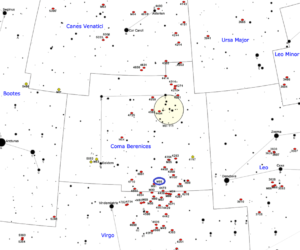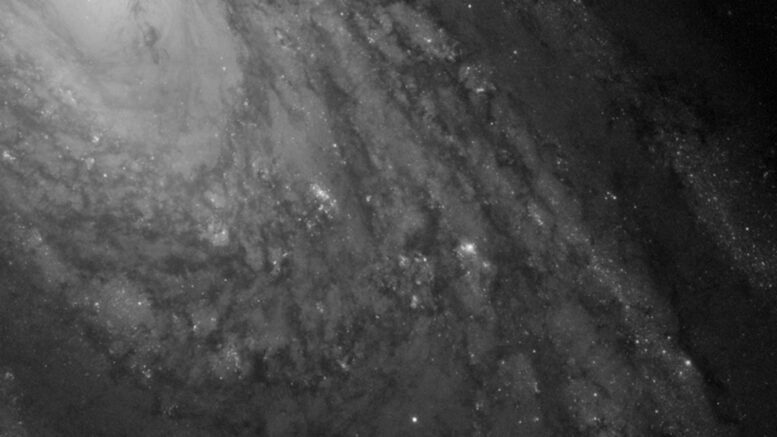Messier 88 is a spiral galaxy located in the Virgo Cluster, in the constellation Coma Berenices. The galaxy’s core contains an active galactic nucleus (AGN) with a supermassive black hole with an estimated mass of 107.9 solar masses. The nucleus rotates more quickly than the Milky Way’s. Messier 88 is one of the 15 Messier galaxies that belong to the Virgo Cluster. It is suspected to have a highly elliptical orbit, one taking it toward the cluster’s core and the giant elliptical galaxy Virgo A (M87).
| Description | |
| Visible From Pacific Northwest | January to May |
| Best Time To Observe | May |
| Minimum Size Of Viewing Device | 10×50 Binoculars |
| Object Type | Spiral Galaxy |
| Designations | Messier 88, M88, NGC 4501, PGC 41517, VCC 1401, UGC 7675, 2E 2758, 2E 1229.4+1442, IRAS 12294+1441, INTREF 503, 2MASX J12315921+1425134, MCG+03-32-059, MITG J123159+1425, VPC 840, Z 99-76, Z 1229.4+1442, WB 1229+1441 |
| Right Ascension | 12h 31m 59.2s |
| Declination | +14°25’14” |
| Constellation | Coma Berenices |
| Number Of Stars | 400 billion |
| Apparent magnitude | +10.4 |
| Apparent dimensions | 6′.9 x 3′.7 |
| Object Radius | 52,500 light years |
| Distance From Earth | 47 million light years |
History
Messier 88 is one of Charles Messier’s original discoveries. The comet hunter found and catalogued the object on March 18, 1781, along with the globular cluster Messier 92 in Hercules and seven other members of the Virgo Cluster in the constellations Virgo and Coma Berenices: Messier 84, Messier 85, Messier 86, Messier 87 (Virgo A), Messier 89, Messier 90 and Messier 91. This is what Messier wrote about his 88th entry:
Nebula without star, in Virgo, between two small stars & one star of the sixth magnitude, which appear at the same time as the nebula in the field of the telescope. Its luminosity is one of the faintest, & resembles the one reported in Virgo, No. 58 [Messier 58].
Charles Messier
John Herschel catalogued the object as h 1312 and later added it to his General Catalogue as GC 3049, describing it as “bright; very large; very much extended; preceding of a double nebula.”
Messier 88 was one of the first objects to be identified as a spiral galaxy. Lord Rosse listed it as one of his 14 “spiral nebulae” discovered to 1850.
A supernova was observed in M88 in 1999, which was classified as a Type Ia supernova. This means that this supernova was triggered by a violent explosion of a white dwarf.
Locating M88 In The Sky
Messier 88 can be found a bit north of the line from the bright star Denebola in Leo to Vindemiatrix in Virgo. The galaxies Messier 84 and Messier 86, which lie exactly halfway between the two stars, can be used to find M88. M88 is positioned to the north and a little east of the pair. The best time of year to observe M88 and the nearby galaxies is during the spring.

Viewing M88
Messier 88 is bright enough to be visible in 10×50 binoculars under good conditions. Small telescopes will reveal an elongated, nebulous patch of light with a brighter centre, while medium-sized equipment will show a well-defined, bright core. The galaxy is best observed in larger instruments, which reveal some of the details of its structure.
Photographing M88
It is indeed possible to capture several Messier objects when capturing Messier 88 in an image. It is indeed possible to capture M88 without 2+ hours of content in terms of photos. Using a 6 inch telescope with automatic guidance, one only needs 20 photos with 300 second exposures with a modified Canon T3i (600D) for example to provide a wonderful photo.
Sources And Further Reading
Descriptions of all of Messier Objects can be found here.
https://www.nasa.gov/feature/goddard/2018/messier-88
https://freestarcharts.com/messier-88

Be the first to comment on "Messier 88"